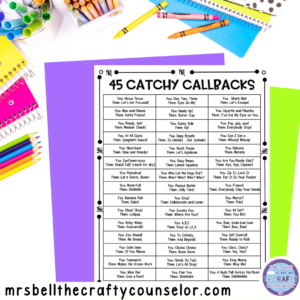Student Attendance Intervention to Help Decrease Absenteeism and Prevent Truancy
Improving school attendance and decreasing truancy and student absenteeism are of utmost importance. At the elementary level, improving school attendance can set the foundation for better grades and higher levels of academic confidence. Student attendance interventions can be a game changer for your students.
In order to succeed in school, students need to be in school. Targeted interventions with frequently absent or truant students can make a difference in their ability to attend school.


Before Your Intervention Begins
Choose Participants Based on Data
Just like some students need interventions in math or reading, some children need interventions in order to learn how to improve their school attendance. Using the attendance data collected by your school, your school-based attendance team can find those frequently absent children who are at risk of becoming truant to participate in your group.
Decide on Necessary Interventions
Once you’ve identified your top students experiencing chronic absenteeism or are at risk for truancy, the attendance team needs to decide on the right intervention and obtain parental permission.
For some students, implementing a morning check-in with an attendance tracker is all the only attendance intervention those students may need in order to improve their attendance.
Accountability and something to look forward to can sometimes be all that is needed to motivate a child (or family) to attend school regularly. For others, a small group curriculum that explicitly teaches the skills needed for attendance success is needed.


No matter the situation or the intensity of the intervention your team would like to put in place, contact with the family is vital.
Contact Families and Break Down Barriers
Attendance at the elementary age is based on many factors outside the child’s control. Before starting an attendance intervention or activity with this age group, contact all families.
As part of the conversation with parents, gently inquire about barriers to their child’s regular attendance. Offer assistance, problem solve with the family and pull in your school social worker as a source of support as needed.
Implementing Your Student Attendance Intervention
Attendance Trackers
Students on my attendance watch list receive an attendance tracker and instructions for daily check-in points of contact. On Mondays, the student picks up a blank tracker from a designated location at the front desk and brings it to their designated check-in person.
Each morning, the student is responsible for checking in with their check-in person and having the attendance tracker signed.
On Fridays, the student turns in their tracker to the front desk secretary, who in return gives the student a ton of kind words, a sticker, pencils, a small treat, etc if they reach their attendance goal.
It works beautifully.


Recruit Staff Members
We can’t be everywhere. Having numerous staff members willing to help with this attendance intervention and check in with students increases the number of students who can benefit from this intervention. As the school counselor, I facilitate the matches between students and staff, supply and collect the trackers, and refill the prize container from donated supplies from the supply closet. The rest runs on autopilot.
Small Group Intervention
Attendance Trackers and Get to Know Yous
Students with a history of absenteeism, those who are considered truant, or those who you feel need extra assistance may be a good fit for small group counseling sessions.
Due to the more sensitive nature of this group, I meet with each student one-on-one ahead of time. Explain the purpose of the group in a positive light without placing guilt or shame about the absences.
During this meeting, I share the attendance tracker with the student. Attendance trackers offer a great opportunity for quick daily one-on-one meetings. These daily meetings can help build rapport and minimize absences with my frequently absent students.


Knowing someone is waiting for you makes you more likely to want to show up.
Check-Ins Daily
My morning duty is to be the over-caffeinated smiling lady holding open the front door, saying good morning too excitedly. Students know exactly where I am and how to find me. My group members are responsible for coming to me daily to sign their attendance tracker.
I keep their trackers on a clipboard that I bring with me to morning duty each day. I tied a pen to the clipboard because I always lose my pens.
When group members come to check in with me, we say our good mornings, catch up quickly and set a positive mindset for the day.
What is one thing you are looking forward to today? Once they answer that question, I sign their tracker, and they are off to class.
Knowing that I am waiting for them to come and sign their trackers helps to keep them accountable and motivated to come to school daily.
Each day they get their tracker signed, they get the point. They can trade those points in for prizes.
It’s a fun and effective way to get kids wanting to come to school every day.


Student Attendance Intervention Weekly Meetings
As part of my six-week group, students have their attendance trackers checked daily and attend weekly attendance meetings. At these weekly meetings, students reflect on their attendance the past week and participate in an attendance skills lesson. The attendance skills taught during group help break down barriers to attendance success.
After using data to identify and reach out to the family of the top 25% of students who are frequently absent or tardy, I implement my targeted student attendance improvement program.
Here is how I run my six-week attendance small group for frequently absent, truant, and tardy students at my school:
Week One


Week one is about breaking the ice and getting students comfortable enough to participate in the activities for the upcoming six weeks. Students gain so much more from the group if they participate in the group. Help to make them comfortable.
After a quick icebreaker activity, like telling a boring fact about yourself or sharing which animal they would want to be, students introduce themselves. I like to have students sit in a circle and introduce themselves one by one. They work together to create group norms, taking ownership of and agreeing to a universally accepted set of rules for their time together.
They are given some time to complete the “Pieces of Me” activity. The option to share their activity sheet as a group, with no pressure to share if they aren’t ready.
Lastly, students take a pretest allowing me to access their knowledge and guide our future meetings together.


We review our check-in plan and agree on where to meet in the mornings to sign our attendance trackers. Once the activities are complete, we set an attendance goal (for example, four out of five days attending school on time) and say our goodbyes.
Week Two
We say our hellos and engage in an icebreaker activity such as rose and thorn, one good thing that happened, and one thing we are working on or trying to make better. We review our attendance trackers from the past week and talked about what helped and harmed our ability to attend school.
After we break the ice, we move on to our activities.


This week’s activity is a true/false card sort. Looking at each card one at a time, students think about the written statements and decide if they are true or false.
They then drop the statement card into the appropriately labeled container.


We then review an “Attendance Fact Sheet” and think about if we want to change any of our answers or how we sorted the cards.
All group members agree to review the “Attendance Facts Sheets” again with their parents.
The session is closed out with an activity sheet that allows students to think about the specific factors that affect their attendance.
Week Three
This week we learn about routines that set us up for attendance success. Group members create and establish their own routines that lead to attendance success as they complete a cut-and-glue activity.


Week Four
Students participate in activities that help them think more deeply about factors and situations affecting their attendance success. Group members are given puzzle pieces that, when matched, display examples of things that help and hurt our attendance.
Students put the puzzle together, read the scenarios, and answer the questions. Warning: When engaging in this activity, amazing discussions will follow.


We solidify our understanding with this “What Would You Do” Activity Sheet.
It is so fun listening to the examples my students come up with.

Week Five
Now that students have a foundational understanding of factors that affect attendance, students are challenged to think about how their choices affect their attendance. We complete the interactive activity and identified the outcomes and consequences of various choices.


Week Six
With our group coming to an end, we recap all we’ve learned and discuss our plans for the future. Students complete a cut and glue activity that allows them to write a letter to themselves and seal that letter in an envelope.
Students take the time to write a letter to themselves, setting a specific goal for reducing their absenteeism.




We then close our group and say our final goodbyes.
Follow-Up
Even though our sessions and group meetings are over, you can still continue with the daily check-ins and attendance trackers. It is helpful to continue this with each student at least for a short while after the group ends to help hold members accountable for their attendance. This check-in and continued contact will further the chances of continued improved attendance.

So, if this sounds like it might be a good fit for your students, you can download your own copy of this six-week small group attendance intervention. Check out this student attendance intervention on TpT and The Crafty Counselor Store.
You might also like my attendance flipbooks, truancy prevention strategies, or ways to build rapport as you get to know students’ families.
Let’s Connect:
- Follow Me on TeachersPayTeachers
- Like My Page on Facebook
- Connect With Me on Instagram
- Pin With Me on Pinterest

For more resources like this student attendance intervention small group lesson plan, check out The Crafty Counselor Store.
Read more...
Share it...
You might also like...

Hi, I'm Ashley!
I am a school counselor who helps educators to change the lives of students with engaging, creative, and meaningful SEL resources.




